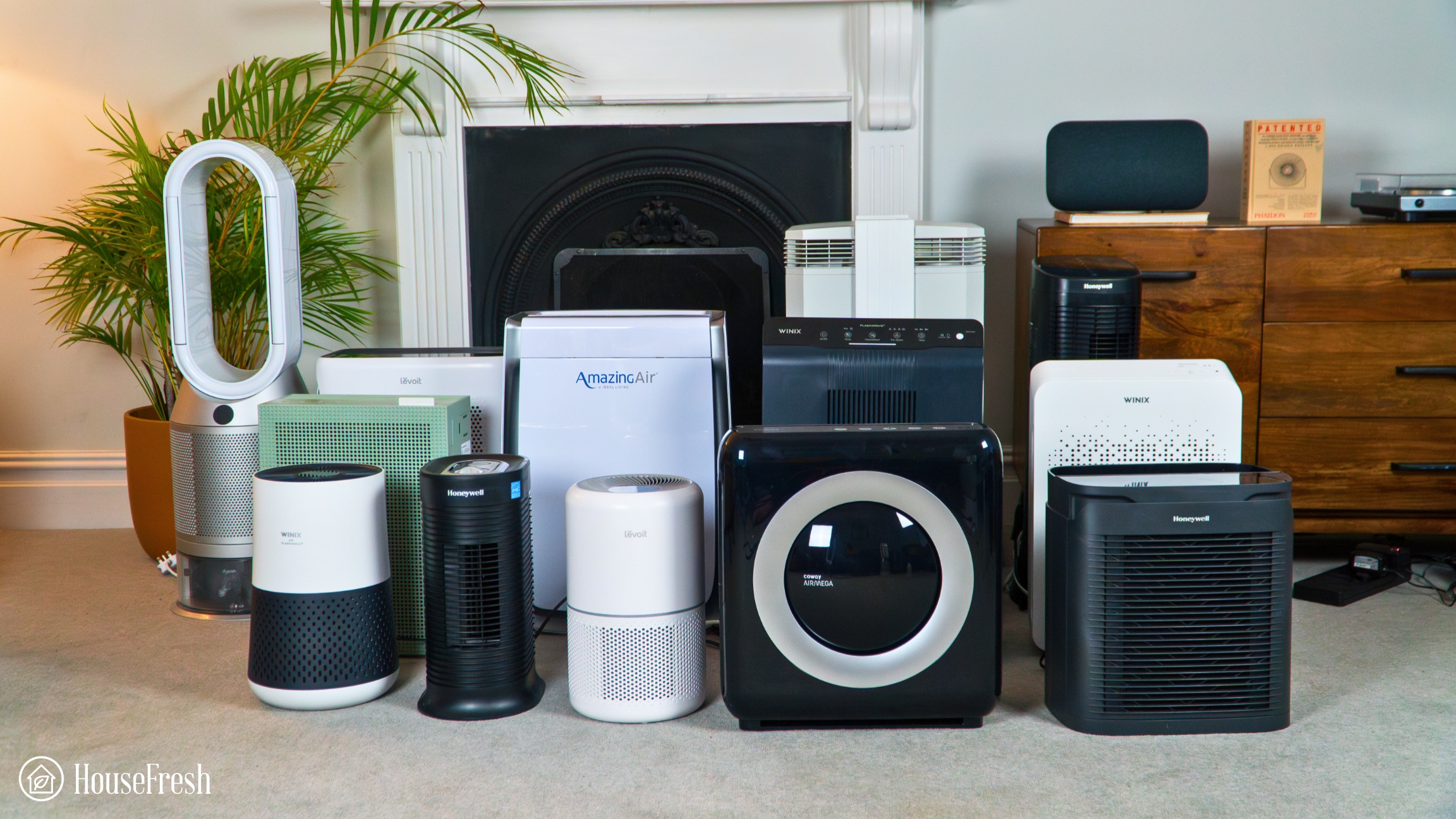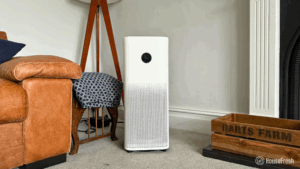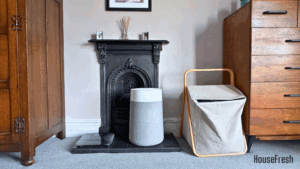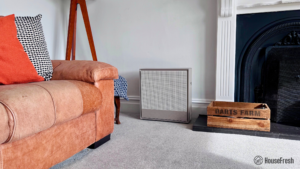Developing products since the late 80s, Coway has been at the forefront of performance and design. With their large range of products, they aim to challenge the boundaries of conventional air purifiers by adding innovation without compromising performance.
I was impressed with both the Airmega 300 and the Airmega AP-1512HH Mighty when we tested them in our home lab, and they’re both unique compared to the traditional looks of other boring air purifiers. (I’ve been pestering Danny to buy the Airmega IconS to review. Feel free to help me out and email him to request it.)
Another addition to the Airmega range is the 150, which Coway says is “compact, quiet, and powerful combined with unique design.” This bold air purifier is available in three colors, has built-in air quality sensors, and features a color-coded AQI.
But is this a case of style over substance? In this review, I delve into the Airmega 150 to look at its design, features, filters, and, most importantly, how it performs compared to rival units on the market.
The lowdown on the Coway Airmega 150


Don’t want to read the full review? Check out what I like about the Airmega 150 and what Coway could have done better.
What we really like
What we think could be better
| HouseFresh rating: | ★★★☆☆ |
| Time to clean our 728 cubic feet test room (with the device running at top speed): | 33 minutes |
| Air purifier technology: | HyperCaptive™ GreenHEPA™ filtration system |
| Recommended room size (4.8 air changes per hour): | 237 sq. ft. |
| Clean air delivery rate (CADR): | Dust: 161.1 CFM Smoke: 152.8 CFM Pollen: 219.8 CFM |
| Dimensions (in inches / in cm): | 6.5 x 13.4 x 18.5in (16.5 x 34 x 46.9cm) |
| Weight (in pounds / in kg): | 12.1 lbs (5.5 kg) |
| Filter life: | 1 year |
| Noise level in decibels (measured from 3 ft. away with a sound level meter): | Speed 1: 35.2 dB Speed 2: 39.5 dB Speed 3: 55.6 dB |
| Electricity consumption in watts (recorded with an electricity usage monitor): | Standby mode: 0 watts Speed 1: 2.38 watts Speed 2: 6.04 watts Speed 3: 31.55 watts |
| Estimated running cost (electricity consumption + official filter replacement): | $98.11 per year |
| Cost per CADR cfm (based on dust CFM as reported by AHAM): | $1.18 |
| Manufacturer’s warranty: | 3 months |
| Country of manufacture: | South Korea |
A new generation of air purifier design
Coway discards tradition for a look that suits a bold and modern home

Forget bland white appliances. Get some color into your home. We at HouseFresh take our interior design quirks seriously, and it seems as if Coway caught onto that. The 150 comes in three colors: Sage Green, Peony Pink, and Dove White (I guess you can’t completely dismiss the classics).
We went for Sage Green because it matched the color of my couch, and although I like pink, Peony is a little too bold for my taste.

The unit overall is quite sparse. You could easily mistake it for a heater or a speaker from the front.
There’s no obnoxious branding plastered over the grill, just a tag on the top with the Coway name embossed. This tag isn’t just ornamental. Pulling it upwards, you’ll find it’s actually attached to the pre-filter, making it especially easy to remove and clean. Nice feature, Coway.

Looks are subjective, but for me, the 150 looks great. It’s modern, stylish and unassuming. My only gripe is that the whole unit feels a little thin and plasticky. I wish they had used thicker casing like most of the other air purifiers in the Airmega range.
Even then, when you compare it side-by-side with plain, white devices like the Levoit Core 300S, you can clearly see how much Coway has invested in the design stage of this unit:

However, I will say that the Airmega 150’s design doesn’t look totally unique, as other models like the SA600 from Smart Air have similar designs. But it definitely stands out if you compare the 150 to other more traditional air purifiers.

Some brands pack their control panels with smart technology, touch screens, and settings on settings (check out the Mila, for example), but that wasn’t what Coway wanted with the Airmega 150.
They’ve kept it super simple with only three buttons. One controls your unit’s power, another allows you to select fan speed or auto mode, and the last one allows you to configure the machine’s display lights. There aren’t any other notable smart features on the 150, so if you want a timer, display lock, or app connectivity, this isn’t the air purifier for you.

If you look on the side of the Airmega 150, you’ll notice two slots. This is where the air quality sensor lives.

The air quality sensor in the Airmega 150 monitors the number of pollutants present in your room in real-time. The data collected is then relayed to the unit’s auto mode, which adjusts the fan speed according to your present air quality.

When the quality of the air changes, the sensor sends this information to the color-coded AQI on top of the unit.
🔵 Blue = Good air
🟢 Green = Moderate air
🟡 Yellow = Unhealthy air
🔴 Red = Very unhealthy air
3-stage HEPA filter that lasts
Coway covers the bases with their GreenHEPA™ technology and a removable pre-filter.

When brands engineer their own filters, they like to give them catchy names… In the case of Coway, their team has developed the HyperCaptive™ Max2, which has three filtration stages: pre-filter, deodorization filter and
Pre-filter
The pre-filter is the first line of defense, capturing larger particles from the air, like dust and dander. Trapping these larger particles early on means the HEPA filter can focus on the microscopic particles.

I appreciate when brands let you remove the pre-filter so that you can clean it. By periodically cleaning this filter, you can prevent clogging and prolong the HEPA’s lifespan.

Deodorization filter
Coway’s Deodorization filter is basically the carbon layer that removes odors, gasses, and other VOCs from your room. The general rule is the more activated carbon it includes, the more effective it is. Unfortunately, in the case of the Airmega 150, Coway opted for an impregnated fabric that sticks to the front of the HEPA filter to add a layer of odor filtration.

Impregnated carbon fabric is not as effective as activated carbon pellets. You can see in the photo below how flimsy the filter is:

Green True HEPA™ Filter
HEPA filters use a tightly woven maze of tiny fibers that trap microscopic particles like flies in a spider web. HEPA filters are made in different grades. The higher the grade, the smaller the particles they can capture.
Coway states that its Green True HEPA™ filter captures 99.97% of airborne pollutants, such as bacteria, viruses, fungi, and pollen. By applying an antimicrobial treatment to its HEPA filters, these pollutants are thwarted and unable to spread.

Like all Coway devices, the Airmega 150 has been sent for third-party lab testing as part of the AHAM VERIFIDE program. You can see the lab report on the ENERGY STAR Certificate tool. Here are the CADR results:
| Smoke CADR | 152.8 CFM |
| Dust CADR | 161.1 CFM |
| Pollen CADR | 219.8 CFM |
Based on these CADR scores, it should clean our test room in around 34 minutes, give or take a couple minutes.
Find everything you need to know about HEPA filters here, including:
HEPA filters may be the most effective way of trapping pollutants in your air, but here’s the catch: they can get congested and become less effective after a while. This means you need to replace the filters in your air purifier periodically.
When it’s time to replace your filters, a red light will appear on your control panel:
- When the red light illuminates next to the PRE symbol, it’s time to clean your pre-filter.
- When it illuminates next to MAX2, it’s time for a replacement HEPA filter.

Replacing the filter on the Airmega 150 takes less than a minute. Here’s how:
- Switch off and unplug the unit
- Pull the front panel open and reveal the filter
- Remove the old filter and replace it
- Click the front panel back into place
Before installing the replacement filter, make sure you remove all packaging.
If you don’t, the filter will not remove any contaminants from your air, and you’ll probably notice a burning smell coming from your air purifier. Not cool.
The Coway Airmega 150 cleared our test room in 33 minutes
Worthy performance for a unit of this size
To make our reviews as fair and even as possible, we test all the units we review (no matter what size) in the same 728 cubic ft room.
We start by lighting an incense stick in our home lab until the room fills with thick smoke and turn on our air purifier to the highest speed. Next, we sat back to monitor and record how long it took for the Airmega 150 to clear all pollutants from the air using our PurpleAir indoor sensor.

The Coway Airmega 150 took 33 minutes to clear all generated PM1.0 ug/m3, PM2.5 ug/m3, and PM10.0 ug/m3 pollutants from our home lab. This is about what we expected for the size of the unit. However, we would have liked to have seen it perform a little faster for an air purifier that’ll set you back over $160 from a top brand like Coway.
Air cleaning performance test results
I’m not writing this Airmega off, but when you compare it to the Levoit Vital 200S or the Winix 5500-2, you can see why we expected more.
It may not look as good, but the Winix 5500-2 is cheaper and outperformed the Airmega 150 by a massive 13 minutes. So, if you’re looking for performance over design, the 5500-2 might suit you better.
Noise levels test results
A big advantage of running a smaller air purifier is that the fan is usually a lot quieter as the fan and motors are smaller. The Airmega 150 is quiet at its lowest fan speed, notching out just 35 dB, which is the same level as someone whispering nearby. At its highest fan speed, the 150 hits a respectable 55.6 dB, which is the same as moderate rainfall.
When you compare it to other air purifiers of similar size and spec, you see that it falls nicely into its size category without deviating in any particular way.
Noise is subjective; what’s quiet to some is loud to others; that’s why we video air purifiers running at each fan speed so that you have an idea of sound levels for yourself.
Cost of running a Coway Airmega 150: $98.11 per year
Energy-efficient with affordable running costs in the long-term.
When buying an air purifier, it’s not only the unit’s initial cost you need to consider. You also need to look at the unit’s long-term running costs.
1. Electricity costs: $48.12 per year
The first cost you need to look at is the amount of energy the air purifier uses, as some units are more energy-efficient than others. And with energy prices ever rising, it’s an important factor to consider.
Coway knows this and engineers their air purifiers to make them as energy-efficient as possible.
The Airmega 150 is a testament to this, as our energy tests show. We calculated that it should cost around $48.12 to run at full speed, 24/7, 365. This is impressive for its size. Especially when you compare it with the Winix 5500-2, which we calculated to cost almost $35 more annually.
We calculated this cost using the average price of energy in the U.S., as reported by the Bureau of Labor Statistics.
2. Filter costs: $49.99 per year
Another additional expense you can’t avoid is replacing the HEPA filters in the 150. HEPA filters are so effective at trapping particles that the pollutants have nowhere to go, filling the filter up until they become blocked.
How often you change them depends on how hard it works (the amount of pollutants the filter removes). Coway advises replacing the filter in the Airmega 150 every 12 months. But you don’t have to keep an eye on the calendar. You’ll know when your HEPA is full when a red light pops up on the control panel.
You can purchase an official Coway replacement for $49.99.
- Coway Airmega 150 Replacement Filter
- Only fits Airmega 150 (AP-1019C)
- Number of pieces: 2
- Package Dimensions: 1.0 L x 14.5 H x 11.0 W (inches)
Unofficial replacement filters are cheaper, but I can’t testify to their effectiveness.
Bottom line: Should you get the Coway Airmega 150?
The 150 looks like a thousand bucks, but is it worth it when compared to other units?
Coway is never one to shy away from designing their air purifiers with a little extra… flare. As soon as they released the Airmega 150, I loved that they were pushing boundaries again. And the fact that they’ve made it available in different colors makes it more appealing to those who care about the style of their home appliances.

Overall, the Coway 150 is a good-looking air purifier built for a small room that will clean the air as effectively as units like the Levoit Core 300.
I do have a few reservations about 150, though. My main complaint is the lack of pelleted activated carbon. It seems odd when the Amazon listing from the official Coway store includes an image like this one that will make consumers think the filter includes pelletized activated carbon when, in fact, you only get two sheets of impregnated fabric.
If you suffer from allergies or live in a highly polluted area, you will be better off with more powerful units such as the Smart Air Blast Mini or the more affordable Winix 5500-2. However, if you’re just looking to generally improve your air quality without having an ugly white box in the corner, the Airmega 150 will suit your needs.
SOURCES
We calculated yearly costs associated with running the Coway Airmega 150 24 hours a day, 365 days per year utilizing the latest average energy prices as reported by the Bureau of Labor Statistics of $0.174/kWh as of April 2024.






